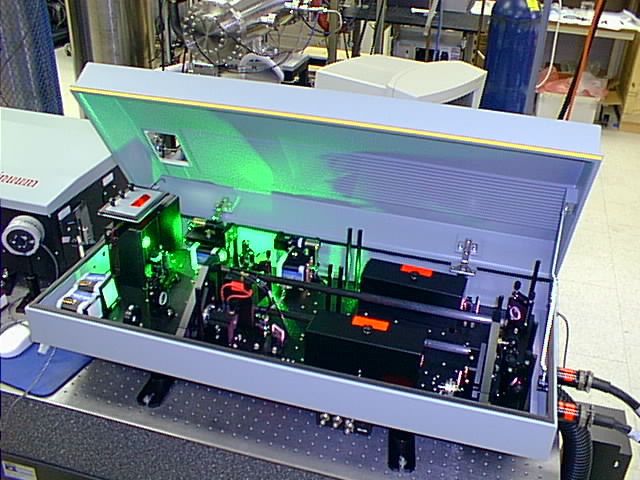
Lasers are a fairly charismatic tool for scientists to use—using a laser is an obvious sign that science is happening in some way shape or form, especially if the laser has many hazard warnings on and around it.
Their applications, even within geoscience, are quite varied. They put the “Li” in “LiDAR.” Lasers are also used to turn very small portions of rocks into tiny dusty bits, in a process called laser ablation (the LA of LA-ICP-MS).
One tricky problem in geochemistry is that of analyzing rocks with a mass spectrometer. Mass spectrometers work only on ionized gases (or plasmas), and rocks are pretty solidly solids. In order to get them into a mass spectrometer, you need to break them down somehow, either through acid digestion or other dissolution method, or by vaporizing/blasting them with lasers.
Laser ablation works because lasers—particularly pulsed lasers—can emit a great deal of energy into a small volume very, very quickly. As I expect you know, rocks are not especially thermally conductive, so when they are heated up by all the laser energy coming in, it doesn’t have anywhere to go and the small volume of rock heats up and is broken into dust fragments and/or vaporized. By flowing a gas like helium or argon over the sample, this dust can be swept along into the plasma torch of an inductively-coupled-plasma mass spectrometer and analyzed.
Lasers used for ablation can be focused to very small spot sizes, from 2 μm to 1200 μm (=1.2 mm). These spot sizes are small enough that zones within a crystal, such as growth bands or inclusions, can be analyzed separately.
For atmospheric work, lasers can be used for spectroscopy, or at least probe the concentration of certain molecules (e.g. H2O, CO2). One of my favorite instruments (perhaps deserving its own Geoscientist’s Toolkit post) is the cavity ringdown spectrometer, where a laser illuminates a cavity with highly-reflective—but not completely reflective—mirrors containing a sample gas between them. A detector then measures the time it takes once the laser is shut off for the light to bleed out of the cavity (ms). From the ringdown time, the concentration of the gas of interest can be measured with high precision, even at very low concentrations. It’s pretty neat.
Really, there are a lot of geoscience things one can do with lasers: this is just a smattering of those uses of the tool.
